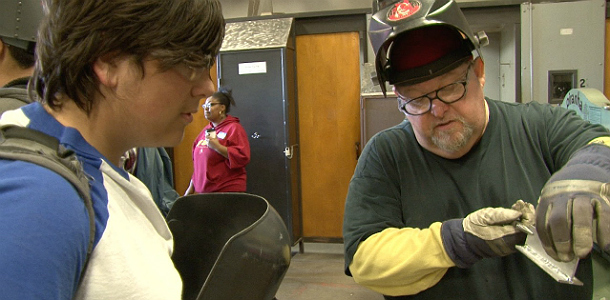
Manufacturing Day demonstration at Cerritos College (Photo Credit: John Guenther/CA Fwd)
Originally published by Lumina Foundation
Many U.S. educators, policymakers, and researchers are looking west to see what the California Community Colleges are doing to prepare for the future. The system is the largest provider of workforce training and higher education not just in California, but in the United States, serving more than 2.1 million students across 113 colleges in 72 districts. The system’s Division of Workforce & Economic Development recently commissioned a report, Charting New Paths to the Future in the California Community Colleges by the Institute for the Future (IFTF). I talked recently with Van Ton-Quinlivan, California Community Colleges Vice Chancellor of Workforce & Economic Development, to pull together this summary of the report.
Why did the California Community Colleges approach the Institute for the Future?
 This economy is already unforgiving to workers without skills, and a future enabled by artificial intelligence and more technologies will be no easier to navigate. Our communities look to higher education to prepare them for today’s jobs and tomorrow’s economies. As difficult as it is for colleges to undertake transformative change, higher education institutions need to engage with the future so that we can be there for students. Our system turned to the IFTF to better understand scenarios of the future so we can better invest in being future-ready.
This economy is already unforgiving to workers without skills, and a future enabled by artificial intelligence and more technologies will be no easier to navigate. Our communities look to higher education to prepare them for today’s jobs and tomorrow’s economies. As difficult as it is for colleges to undertake transformative change, higher education institutions need to engage with the future so that we can be there for students. Our system turned to the IFTF to better understand scenarios of the future so we can better invest in being future-ready.
IFTF is a California-based nonprofit with nearly 50 years of experience in researching long-term change. For this report, the IFTF mapped our current institutional efforts against the larger landscape of innovation they identified in their Learning is Earning in the National Learning Economy research. This research argues that the landscapes of working, learning, and living are increasingly blending. The big question ahead is, what will the world look like for learners and workers in 10 years? IFTF’s Charting New Paths to the Future in the California Community Colleges report shows we have innovated much but there is significantly more to do.
How does this new report link to the framework the California Community Colleges has developed to chart paths to the future?
Over the past five years, we introduced dramatic systemic changes—especially in forming what IFTF calls “solutions networks”—under a framework called Doing What MATTERS for Jobs and the Economy. Colleges are now connected in many more ways that enable the network to problem solve (e.g., by sector and region) and in ways that take advantage of our scale. We ushered in a more supportive environment for innovations that solve workforce gaps by aligning the funds, metrics, and data. These developments have given us a solid start toward moving the needle on student success that lead to workforce outcomes and close the equity gap.
How extensive is the picture of the future that IFTF has laid out?
Very extensive. IFTF carefully researched the drivers of change and evidence-based innovations that are happening all around us. Their map features eight “zones of innovation” and which of our initiatives move us forward in those innovation zones—they call this moving from the “first curve” to the “second curve.” Seeing our efforts visualized along the “two curves” is very provocative and helps us take a step forward in our thinking about how best to serve future students and employers.
What have you learned by linking this future landscape planning with California’s framework planning?
The California Community Colleges system has made advances in all eight of IFTF’s innovation zones. One benefit of our experimentation under Doing What Matters for Jobs and the Economy is that we now better understand how to take innovation to scale, starting with 10-college adoption, then 30, 70, and finally 113.
Case in point, instead of a one-college approach to address employers’ concerns over applicants’ lack of “soft”/employability skills, we sought a 10-college network. Their solution—21st Century Skills—quickly spread to 22 colleges, and we expect it to apply to 35 colleges before 2018. In the New World of Work, we embedded experimentation with badging, where employers can issue badges to interns when they demonstrate the necessary skill(s); Mozilla Foundation named it a promising practice in open credentials.
Our system now offers more fertile conditions to support the important technology and data needed to deliver on the “second-curve” student experience. Students will not only unbundle and rebundle courses, credentials, and programs across education institutions but also learnings gained elsewhere as part of establishing their “dynamic reputation.” Data mining and predictive analytics will allow for “algorithmic matching” over current best guesses. These possibilities must be technology-enabled.
What are the main areas in which you expect to make major changes in the next several years?
Inspired by the IFTF’s report, we see the need for a lot more systemic change and experimentation — much of which will affect the teaching and learning process. For instance, we should do all the following:
- Shift community colleges from a one-time destination where people go (to earn transfer credits, a certificate, or degree) to an ongoing educational resource that provides continuous upskilling and reskilling as the economy demands.
- Personalize all aspects of the learning experience so it aligns with students’ work and life aspirations, from how they receive guidance to recognizing more diverse educational goals.
- Better integrate learning beyond the classroom by providing online resources and off-campus experiences where students can learn and practice their skills in context.
- Help students build up their digital reputations and explore ways to verify non-classroom experience and skills.
- Push harder on our education technology and data infrastructure in order to better support a future of personalized student experiences.
These are ambitious goals. Are they achievable?
This is a journey, not a destination. California needs a strong workforce to drive economic and social mobility. Our 113 community colleges serve as the linchpin for meeting those workforce needs. We pulled off some significant changes over the last few years, changes that some in the system thought impossible (check out our progress at DoingWhatMATTERS.cccco.edu). We’ll be doing more under the banner of guided pathways in the next phase of work.
What advice do you have for other community college systems as they chart their course to the future?
Change leadership is hard. I welcome conversations with other higher education leaders who seek to future-proof their organizations. This work is a team sport, not an individual one.
Holly Zanville is Lumina Foundation’s senior advisor for credentialing and workforce development. She also is an advisory director for the Institute for the Future’s Learn and Work Futures Initiative.

